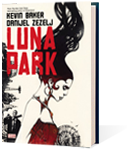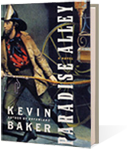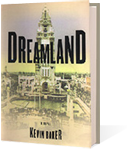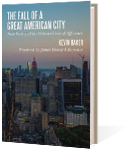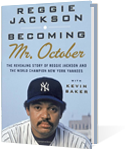Murder of the Century:
The Gilded Age Crime that Scandalized a City
and Sparked the Tabloid Wars
by Paul Collins
Crown
313 pages
The body parts began popping up all over New York during the scorching summer of 1897. A man’s chest and arms in the East River, a lower torso and hips up in East Harlem, and soon it was clear that murder was afoot.
At least, it was clear to the city’s ravenous newspapers. The police, more interested in beating strikers and bullying prostitutes than scrutinizing unstuck limbs, attributed the appearance of these remains to the regular pranks played by medical students of the time, one of the many terrific tidbits to be found in Paul Collins’s immensely entertaining history: “The city had five schools that were allowed to use cadavers, and parts of them showed up in the unlikeliest places: You’d find legs in doorways, fingers in cigar boxes, that kind of nonsense.”
The city’s morgue attendants, who could be suborned for as little as a “cigar or a pouch of shag tobacco,” were also inclined to put these grisly finds down to those rascally doctors-to-be, but the next thing they knew, reporters from the World, the Herald, and the Evening Telegram were at their door, with New York’s medical examiner and the superintendent of Bellevue Hospital in tow.
These worthies, with the help of the assistant coroner, noted several striking details over the next few days: the man had been dead for less than twenty-four hours; his head had been sawed off the torso in a manner too crude for any medical student; a patch of his chest had been carved away as if to remove some identifying mark; and the stumps of his legs had been boiled.
The press took it from there. The summer of 1897 marked the red-hot climax of the city’s newspaper wars, waged primarily between New York’s presiding circulation king, Joseph Pulitzer’s World, and the usurper, William Randolph Hearst’s Evening Journal, with the other dozen English-language dailies trying to hang on.
Their competition was—both figuratively and literally—the most colorful period in American journalism. Hearst, the young interloper from California, was willing to use as much of his vast inherited mining fortune as necessary. Churning through one fragile, state-of-the-art color press after another—“Smash as many as you have to, George,” he would tell his printer—the Journal produced funny pages that were, if it said so itself, “eight pages of iridescent polychromous effervescence, that makes the rainbow look like lead pipe.”
Pulitzer responded with his own brilliant Sunday supplements, which were also printed in fantastic colors and which, as Nicholson Baker would put it, “weighed as much as a small roast beef.” The two papers slashed their ad rates, cut their newsstand price down to a penny, turned out endless extra editions, and raided each other’s leading editors, writers, and cartoonists.
Yet most of their battles were still decided by good old-fashioned reportorial leg work. In this, no subject was below scrutiny—“race riots in Key West, idiots stealing electricity off high-voltage streetcar lines in Ohio, and two millionaires fighting over a $15 dog.” But best of all remained what Pete Hamill would label “murder at a good address”—not a sad, tawdry “economic” killing, but one, as the song goes, full of passion, jealousy, and hate.
The segmented corpse in the New York morgue had all the markings of such a crime, and the newspapers mustered every resource at their disposal. In the case of the Journal, this meant turning out the “Wrecking Crew,” “a mob of mustachioed, derby-hatted men [who] would come tumbling out” of its building on Newspaper Row every day in pursuit of the latest scoop, while their editor yelled, “Get excited. God damn it, get excited!”
Whatever their Keystone Kops appearance, the reporters worked with incredible verve and ingenuity. Within three days, the World, Journal, and Herald all had essentially cracked the case. For the first time in newspaper history, the Journal put color on the front page, to vividly depict the oilcloth in which the body parts had been wrapped.
While the police let thousands of rubberneckers parade through the morgue, and listened as everyone from palmists to pathologists attributed the murder to “a female Jack the Ripper,” “some secret society,” a cannibal, or “fiendish” Spaniards who “hacked him to pieces with their machetes,” one Ned Brown, a nineteen-year-old cub reporter for the World, took a good look at the corpse’s powerful hands and arms. They reminded him of those of the masseurs at the Murray Hill Baths, “The House of a Thousand Hangovers,” where reporters were known to sweat out woozy nights on the town.
Brown discovered that a womanizing masseur there named Willie Guldensuppe hadn’t been to work for days. Before the day was out, he had disguised himself as a soap salesman; gained access to the apartment of Guldensuppe’s alleged lover, a licensed midwife named Augusta Nack, who was tidying up before taking the next steamer back to her native Germany; purloined a photograph of Willie from her shelves—and even sold her two bars of soap.
All of Brown’s hard work would be squandered. The World suffered from the absence of its blind, neurasthenic leader, who bombarded his staff with unhelpful anti-Hearst wires from his soundproofed mansions and yachts, ordering, “We must smash the interloper.” Hearst, on the other hand, was on site and as vigorous as his reporters. When the World foolishly buried Brown’s scoop on page two, Hearst himself jumped on a bicycle and raced the fifty blocks from Printer’s Square to the Nack tenement at Thirty-Fifth Street and Ninth Avenue—the Wrecking Crew huffing behind him, in one of the many indelible scenes with which Collins delights us. There he immediately rented Mrs. Nack’s apartment (her lease had just ended), posted a guard of Journal reporters around the building to keep out competitors, and proclaimed in a headline that evening: MURDER MYSTERY SOLVED BY THE JOURNAL. MRS NACK, MURDERESS!
It would not be quite that simple—which was just fine by the city’s newspapers, the Journalincluded. Was it really Mrs. Nack who had killed poor Willie? Was it her brutish ex-husband, Herman? Or was it another lover, a brooding German barber called Martin Thorn, whom Guldensuppe had recently pummeled for the sake of the mysteriously irresistible Augusta? And was it really Willie in the morgue? There was the matter of that missing head, which inspired both the Journal and the World to drag the East River, while gleeful crowds watched from the piers and called out things like “Three cheers for Guldensuppe!” and “Try a fine-tooth comb!”
Was there ever a gaudier era in New York history? Was there ever a better time to be a newspaperman?
Mrs. Nack and Thorn were soon arrested, but the case continued for months. Reporters for the World discovered the lonely, rented house out in rural Woodside, Queens, where Guldensuppe was murdered; reporters for the Journal bribed a trusty in the Queens County Jail to give them a note he was carrying from Nack to Thorn encouraging him to kill himself. Journalists visited freely with the suspects in their cells and elicited their life stories.
The trial itself provided still more revelations and attractions. Herman Nack told police that Augusta, like many midwives, was part of the vast network that ran New York’s illicit abortion business. She burned in the family stove two to three fetuses a month for eight to ten years, gave others to a local undertaker to bury, and kept still more in specimen jars to sell to those irrepressible med students. (He claimed at least two young women also failed to survive his ex-wife’s operations.)
Then there was Martin Thorn’s attorney, the legendary William Howe. The diamond-studded, three-hundred-pound Howe, the son of an English brothel keeper, had done hard time in that country for impersonating a lawyer. Reinventing himself as one of the top defense attorneys in America, he had handled 650 murder and manslaughter cases, and was famous for disrupting trials. Everyone complained that the air in the Queens courthouse was so foul they could barely proceed; afterwards, workmen discovered one hundred dead rats in the courtroom’s vents. Howe had no comment.
The yellow press had a field day. The Journal plugged the newsroom in via telephone cables—court to printing press in one minute—and purchased champion racing pigeons named Aeolus, Flyaway, and Electra to rush sketches to Newspaper Row. New Yorkers were entranced, lining up to view a museum waxworks of the killing or to get tickets for the fetid courtroom.
“Events seem to indicate that men, like dogs, go mad at certain seasons,” Hearst had observed at the start of the whole episode, and by the next season he would be back to drumming up war with Spain over Cuba, and making a truce with the World toward their common goal of cutting losses and crushing a newsboys’ strike. He would always look back fondly on the Guldensuppe case: “Ah well, we were young. It was an adventure.”
Paul Collins makes it a splendid one, although his book is not without flaws, starting with its dubious title. Murder of the Century? Hello! Lincoln? More locally, there was that sitting US vice president, Aaron Burr, shooting a Founding Father, Alexander Hamilton. Ultimately, the Guldensuppe murder had no more significance than an especially clever episode of Law & Order. Old New York, red in tooth and claw, produced similar, press-fanned sensations every couple of years.
The title is indicative, rather, of the latest creeping fungus in publishing, the invention of an entire genre known as “narrative history.” Its ideal is Erik Larson’s The Devil in the White City, and it is based on the condescending premise that people will not read history unless it is wrapped around a good, gory murder, and preferably a serial killer.
To get a better overall history of the yellow journalism wars, one might turn to other sources, such as James McGrath Morris’s outstanding new biography of Pulitzer. But Collins, the author of seven books, an assistant professor of English, and Weekend Edition’s “literary detective,” compensates for such industry manipulations. He has done prodigious research, has an eye for the telling detail, and manages to send frissons of Gothic horror running up the spine just with his descriptions of the spooky house out in Woodside where Guldensuppe met his end. He has attained the old newspaperman’s highest standard, which is to root out a good story and tell it well.

